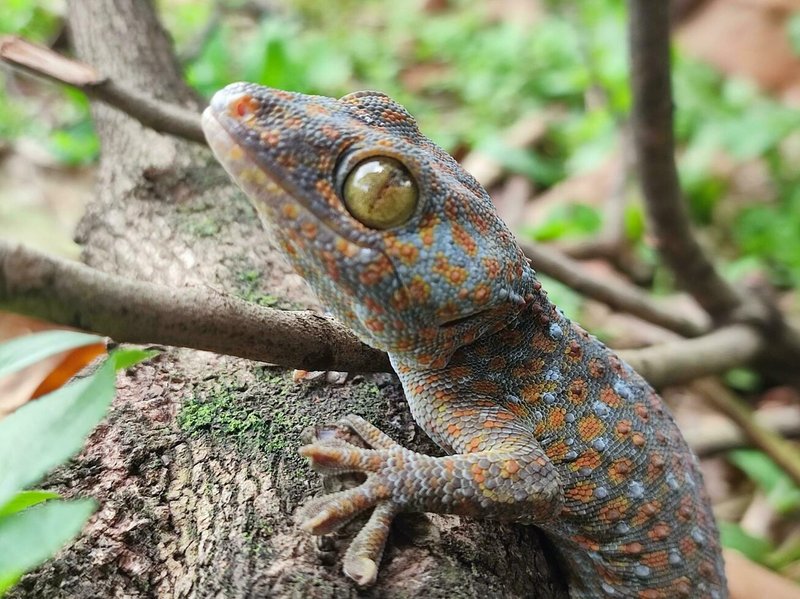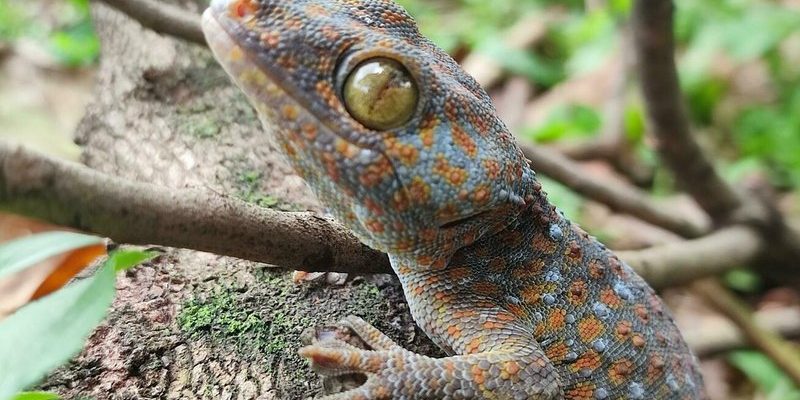
Tokay geckos are not just fascinating because of their looks or their unique sounds. These reptiles have woven themselves into the fabric of life in Southeast Asia and beyond. They represent courage, resilience, and even good fortune in various cultures. You might be wondering, “What makes this little creature so special?” Let’s dive in and explore the many layers of meaning behind the Tokay gecko.
Symbolism in Southeast Asia
In many Southeast Asian countries, the Tokay gecko is often viewed as a powerful symbol. Its presence is frequently associated with good luck and prosperity. People believe that if a Tokay gecko appears in your home, it brings wealth and success. For instance, in countries like Thailand and Malaysia, these geckos are a common sight in homes and businesses alike.
Beyond luck, the Tokay gecko embodies courage. Its loud call, which can be quite startling, is a declaration of its territory. This audacity resonates with cultural narratives about bravery and determination. Imagine hearing its call echoing through the night; it’s as if the gecko is reminding everyone that it’s not afraid to stand its ground.
Moreover, in some cultures, these geckos are linked to ancestral spirits. Some people believe that the appearance of a Tokay can signify a message from loved ones who have passed away. This connection elevates the gecko from a mere animal to a spiritual figure, bridging the world between the living and the departed.
Folklore and Myths
Tokay geckos have made their way into various folklore and myths. In the Philippines, for example, there’s a popular tale about how the gecko was once a human who, after a series of challenging trials, transformed into this striking lizard. This story emphasizes the themes of transformation and resilience, which are central to many cultural narratives.
In other regions, tales speak of the Tokay gecko possessing magical abilities, such as warding off evil spirits. People often hung paintings or carved figures of the gecko in their homes for protection, believing that its spirit would keep them safe. This intertwining of belief, nature, and the supernatural adds layers of intrigue to the Tokay’s significance.
There are even stories where the Tokay gecko is depicted as a guardian. In some communities, it’s said that if you treat a Tokay with respect and kindness, it will bring you blessings. On the flip side, harming one could lead to misfortune. Such tales foster a sense of reverence for these animals, encouraging a harmonious relationship with nature.
The Tokay Gecko in Modern Culture
The Tokay gecko hasn’t just remained in the realm of ancient myths. In contemporary culture, it’s been embraced in various forms of art, music, and even fashion. Artists often use its striking appearance to convey themes of resilience and beauty, while musicians might reference it in songs about love and courage.
In recent years, the Tokay gecko has gained notoriety on social media platforms, where it’s celebrated for its unique looks and characteristics. You might come across videos showcasing their climbing skills or their fascinating feeding habits. This has helped to introduce a younger audience to the importance of biodiversity and conservation efforts.
Despite its cultural significance, the Tokay gecko faces threats due to habitat loss and illegal wildlife trade. Many conservationists are now advocating for its protection, emphasizing the need to preserve not just the species, but also the cultural stories and symbols they represent. This ongoing dialogue about conservation and culture intertwines beautifully, highlighting how important it is to understand and protect our natural world.
Cultural Practices Involving Tokay Geckos
In some cultures, keeping a Tokay as a pet is not just for companionship but is also seen as a way to invite good fortune into one’s life. Many people believe that having a Tokay in the home fosters a positive atmosphere, making it an integral part of daily life. This practice often involves specific rituals to ensure that the gecko is cared for properly.
Interestingly, while some folks view these geckos as a symbol of protection and luck, others use their skins or body parts in traditional medicine. While these practices can be controversial and raise ethical questions about wildlife conservation, they reflect deep-rooted beliefs in the gecko’s power to heal and protect.
Moreover, the Tokay’s loud call is often interpreted differently across cultures. For many, it signals change or a shift in circumstances. If a Tokay gecko calls near your window, it could mean that good news is on the horizon. This connection to the natural world and its rhythms underscores a powerful relationship between humans and their environment.
Conservation and Cultural Heritage
As we’ve discussed, the Tokay gecko has a strong cultural presence, but it also faces significant threats. Urban development, deforestation, and illegal wildlife trafficking have put immense pressure on their populations. Many communities that hold these creatures in high regard now find themselves caught in a dilemma: how to honor their cultural significance while ensuring these geckos don’t disappear from our world.
Conservation efforts are increasingly focusing on merging cultural heritage with wildlife protection. Many organizations are recognizing that protecting the Tokay gecko isn’t just about saving a species; it’s about preserving the stories, beliefs, and traditions tied to them. By involving local communities in conservation strategies, it’s possible to foster a sense of responsibility and pride in protecting these iconic creatures.
Engaging local cultures in conservation efforts can also lead to more sustainable practices. Workshops and educational programs can help spread awareness of the Tokay’s role in the ecosystem while respecting the cultural narratives that make it significant. This collaborative approach ensures that the Tokay gecko can thrive for generations to come.
The Tokay Gecko: A Cultural Lens
As we’ve explored, the Tokay gecko serves as a fascinating cultural lens through which we can understand resilience, tradition, and the intricacies of human-animal relationships. Its symbolism transcends mere superstition and brings forth an appreciation for the natural world.
Whether it’s through stories passed down through generations or its vibrant presence in modern media, the Tokay continues to inspire curiosity and respect. So, the next time you hear a Tokay’s call, remember that it’s more than just a sound; it’s a reminder of the rich tapestry of culture and symbolism it represents.
In conclusion, the importance of the Tokay gecko in culture and symbolism cannot be overstated. It’s a creature that embodies courage, tradition, and the deep connections we have with our natural surroundings. By recognizing and respecting this significance, we can help ensure that the stories of the Tokay gecko live on, enriching our lives and cultures for years to come.

